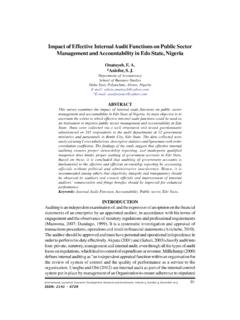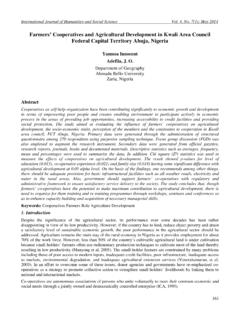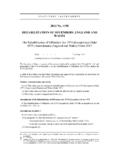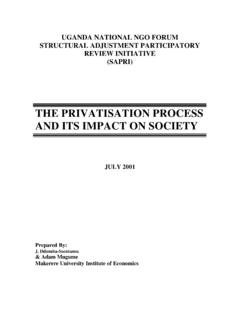Transcription of Strategic Tourism Planning for Sustainable Destinations ...
1 Strategic Tourism Planning for Sustainable Destinations and Sites LUDWIG G. RIEDER. 6th UNWTO Executive Training Program, Bhutan 25th - 28th June 2012. The Policy Challenge in the Asia Pacific Region 1. The rapid growth of Tourism in our region can make substantial contributions to socio-economic development 2. However, unmanaged rapid growth will lead to unsustainable outcomes and impacts at the site and destination level 3. Creating, and maintaining an effective policy framework to plan, develop,, operate, and market Sustainable Destinations and sites is probably the single biggest challenge faced by us today 4.
2 This presentation seeks to lay out some concepts and approaches that may help you to meet this challenge Overview of Presentation A. What do we mean by Sustainable Tourism Destinations and sites? B. Planning as a key tool for ensuring the development, marketing and management of Sustainable Tourism Destinations and sites? C. Marketing Sustainable Tourism sites and Destinations A. What is meant by a Sustainable Tourism destination/site? 1. Demonstrate Sustainable destination management practices 4. Maximize 2. Maximize benefits to social and communities, visitors and Sustainable economic benefits to host heritage, and Destinations community and minimize negative and sites minimize negative effects impacts 3.
3 Maximize benefits to the environment and minimize negative impacts Source: Global Sustainable Tourism Council, June 2012. KEY INDICATORS OF Sustainable TOURIST Destinations AND SITES. Enhancing Cultural Minimizing and Effective Sustainable Optimizing socio-economic heritage/mitigating mitigating negative management benefits for local communities negative impacts environmental impacts 1. Sustainable Management plan 1. Local communities included in 1. Visitors follow 1. Strong conservation of is present Planning process guidelines and codes of resources ethic exists behaviour 2.
4 Compliance with international 2. Local residents given priority in 2. Limited trafficking in 2. Strong compliance and national standards employment and training artifacts, wildlife, etc. with pollution control measures 3. Periodic update training of 3. Purchase of local goods and 3. Tourist enterprizes 3. Strong compliamce management personnel services are encouraged contribute to the with measures to protect protection of natural and biodoversity, ecosystem cultural heritage and landscapes 4. Visitor satisfaction 4. Local entrpreneurs have a place 4.
5 Local architectural measurement used to take in the destination/site supply vernacular incorporated corrctive action chain into bulding designs 5. Promotional materials are 5. Code of conduct for activities in accurate and don't oversell indiginous and local communities in place 6. Design and construction 6. Provisions for protecting complies with landuse and vulnerable groups in place respects heritage landscapes 7. Information and 7. Codes for equity in interpretation facilities are employment of women and provided minorities in place, fair wages, legal protection and basic services are nor compromised Source: GSTC Sustainable Destination Crietria BASELINE INDICATORS FOR Sustainable Destinations AND SITES.
6 Baseline Issues Baseline Indicators Effects of Tourism on (i) Ratio of tourists to locals communities (ii) % who believe that Tourism has helped bring new services or infrastructure (iii) Number and capacity of social services available to the community Sustaining tourist (i) Level of satisfaction by visitors (questionnaire-based). satisfaction (ii) Perception of value for money questionnaire-based). (iii) Percentage of return visitors Tourism seasonality (i) Tourist arrivals by month (ii) Occupancy rates for accommodation (iii) % of business establishments open all year (iv) Number and % of permanent tourist industry jobs Economic benefits of (i) Number of local people (and gender ratio) employed in Tourism Tourism and ratio of total employment).
7 (ii) Revenues generated by Tourism as % of total revenues generated Energy management (i) Per capita consumption of energy from all sources (ii) % of businesses participating in energy saving programs (iii) % of energy consumption from renewable resources Source: Indicators of Sustainable Development for Tourism Destinations A Guide Book by UNWTO 2004. BASELINE INDICATORS FOR Sustainable Destinations AND SITES. Baseline Issues BaselineIndicators Water availability and (i) Water use: (total volume consumed and litres per tourist per day).
8 Conservation (ii) Water saving(% reduced, recaptured or recycled). Drinking water quality (i) Percentage of Tourism establishments with water treated to international potable standards (ii) Frequency of water-borne diseases Wastewater (i) Percentage of sewage from site receiving treatment (to primary, management secondary, tertiary levels). (i) Percentage of Tourism establishments on treatment system Solid waste (i) Waste volume produced by the destination management (ii) Volume of waste recycled (m3)/Total volume of waste (m3).
9 (iii) Quantity of waste strewn in public areas (garbage counts). Development control (i) Existence of a land use or development Planning process, including Tourism (ii) % of area subject to control (density, design, etc.). Controlling use (i) Total number of tourist arrivals (peak periods). intensity (ii) Number of tourists per m2 of the site ( beaches, attractions), per km2 of the destination, - mean number/peak period Source: Indicators of Sustainable Developmet for Tourism Destinations A Guide Book by UNWTO 2004. B.
10 Importance of Planning 1. Importance of having a framework for identifying Destinations and sites 2. Adopting a results-based framework for Planning Sustainable Destinations and sites C. Marketing Sustainable Tourism sites and Destinations Destination/Site Marketing The destination/site plan should include a marketing strategy A Marketing Plan sets the framework and direction for all marketing activities for a destination covering: o Market research o Product development o Brand development and management o Advertising and promotion o Cooperative marketing opportunities o Product distribution and sales Summary of Presentation A.






